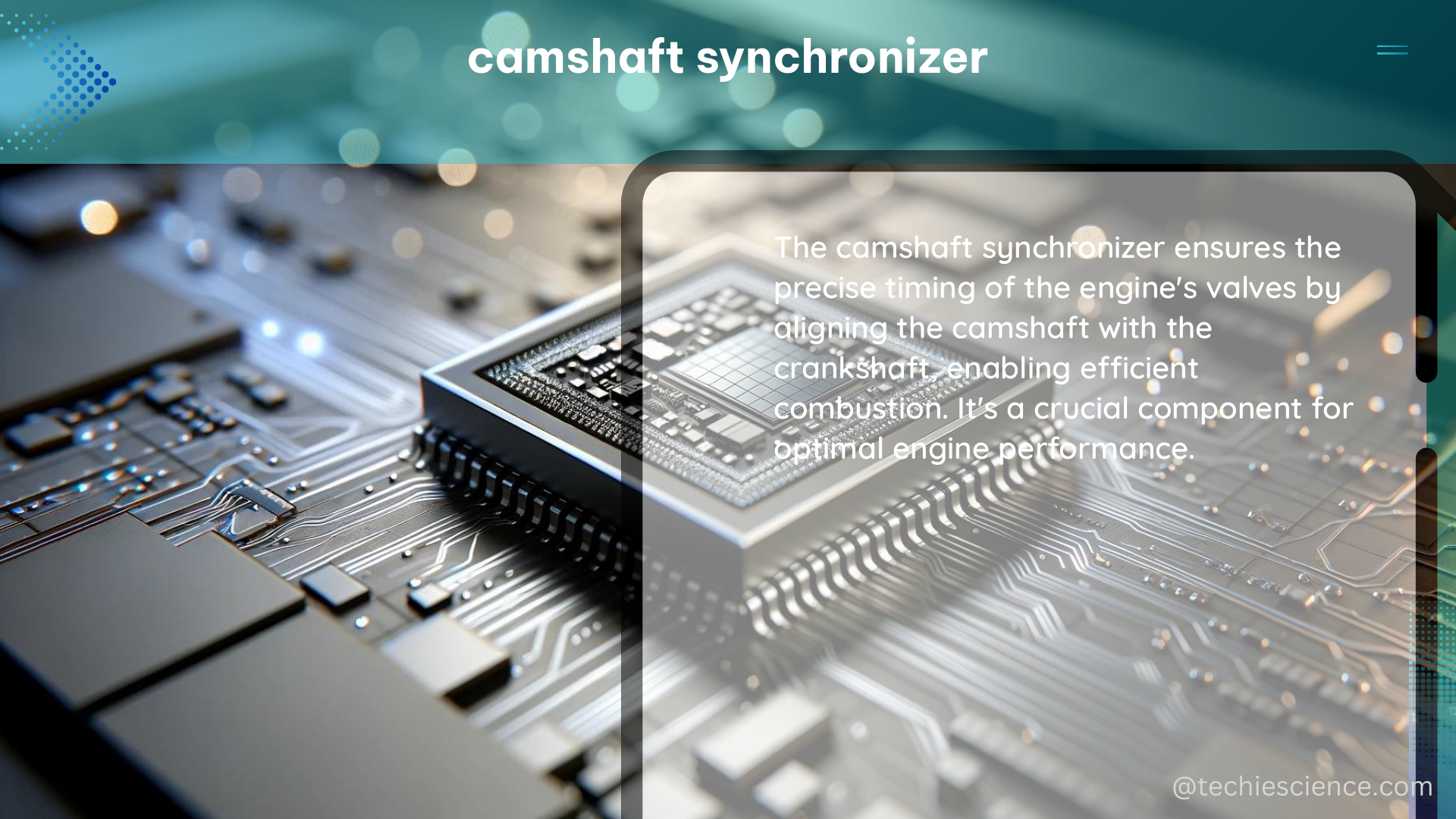The camshaft synchronizer, also known as the camshaft phaser or variable valve timing (VVT) system, is a critical component in modern internal combustion engines. It allows for precise control of the valve timing, which can significantly improve engine performance, fuel efficiency, and emissions. This comprehensive guide will delve into the technical specifications, working principles, and maintenance considerations of camshaft synchronizers, providing you with a deep understanding of this essential engine component.
Technical Specifications of Camshaft Synchronizers
Types of Camshaft Synchronizers
Camshaft synchronizers can be broadly classified into two main types:
- Hydraulic Camshaft Synchronizers:
- These systems use engine oil pressure to control the valve timing.
- The synchronizer is typically located on the camshaft and contains a hydraulic piston that adjusts the camshaft’s angular position relative to the crankshaft.
-
The engine control unit (ECU) monitors various sensors, such as camshaft position, crankshaft position, and throttle position, to determine the optimal valve timing and actuate the hydraulic piston accordingly.
-
Electromagnetic Camshaft Synchronizers:
- These systems use an electric motor and sensor to adjust the valve timing.
- The synchronizer is equipped with an electric motor that physically rotates the camshaft relative to the crankshaft.
- The ECU controls the electric motor based on sensor inputs, allowing for precise and rapid valve timing adjustments.
Angle of Adjustment
The angle of adjustment, also known as the range of adjustment, refers to the maximum degree of camshaft rotation that the synchronizer can achieve. This is typically measured in degrees of crankshaft rotation and can vary depending on the engine design and manufacturer. Common adjustment ranges include:
- ±10 degrees: Suitable for smaller displacement engines with moderate performance requirements.
- ±20 degrees: Commonly found in mid-range engines, providing a broader range of valve timing adjustment.
- ±30 degrees: Employed in high-performance engines, allowing for more aggressive valve timing changes to optimize power and efficiency.
Control System
The control system of a camshaft synchronizer is responsible for monitoring the engine’s operating conditions and adjusting the valve timing accordingly. This control system can be:
- Standalone Control Module:
- A dedicated control module that manages the camshaft synchronizer independently.
-
This module receives input from various sensors and communicates with the ECU to coordinate the valve timing adjustments.
-
Integrated into the ECU:
- The camshaft synchronizer control is integrated directly into the engine control unit.
- The ECU processes sensor data and controls the synchronizer’s actuator based on the optimal valve timing strategy.
Actuators
The actuator is the mechanism that physically adjusts the camshaft’s position relative to the crankshaft. Camshaft synchronizer actuators can be:
- Hydraulic Piston:
- In hydraulic systems, a hydraulic piston is used to rotate the camshaft.
-
The piston is controlled by the engine oil pressure, which is regulated by the control system.
-
Electric Motor:
- Electromagnetic camshaft synchronizers use an electric motor to rotate the camshaft.
- The motor is controlled by the ECU or a dedicated control module, allowing for precise and rapid valve timing adjustments.
Sensors
Camshaft synchronizers rely on various sensors to provide the control system with the necessary information to optimize valve timing. Common sensors used in camshaft synchronizer systems include:
- Camshaft Position Sensor:
- Monitors the angular position of the camshaft relative to the crankshaft.
-
Provides feedback to the control system for precise timing adjustments.
-
Crankshaft Position Sensor:
- Tracks the angular position of the crankshaft.
-
Crucial for synchronizing the camshaft’s rotation with the crankshaft’s movement.
-
Throttle Position Sensor:
- Measures the opening of the throttle, which is an important parameter for determining the optimal valve timing.
- Helps the control system anticipate changes in engine load and adjust the valve timing accordingly.
Maintenance and Troubleshooting

While it is generally not recommended for DIY enthusiasts to attempt major repairs or modifications to the camshaft synchronizer system, there are some maintenance tasks that can help ensure its longevity and proper operation.
Regular Oil Changes
Maintaining the correct type and quantity of engine oil is crucial for the proper functioning of the hydraulic camshaft synchronizer systems. Ensure that you use the recommended oil grade and change it at the intervals specified by the manufacturer.
Inspecting for Leaks
Regularly inspect the camshaft synchronizer and its surrounding components for any signs of oil leaks. Oil leaks can compromise the hydraulic system’s performance and lead to premature wear or failure of the synchronizer.
Monitoring Engine Performance
Pay close attention to any changes in engine performance, such as rough idling, decreased fuel efficiency, or unusual noises. These could be indicators of a problem with the camshaft synchronizer, and prompt attention can help prevent more serious issues.
Diagnostic Trouble Codes
If the engine’s check engine light illuminates, it’s essential to have the diagnostic trouble codes read by a professional. These codes can provide valuable information about the camshaft synchronizer’s status and help identify any underlying problems.
Conclusion
The camshaft synchronizer is a complex and critical component in modern internal combustion engines, responsible for precisely controlling the valve timing to optimize performance, fuel efficiency, and emissions. By understanding the technical specifications, working principles, and maintenance requirements of camshaft synchronizers, you can ensure your engine operates at its best and avoid costly repairs down the line.
References
- Camshaft Synchronizer Technical Specifications
- Handbook of Diesel Engines
- Camshaft Synchronizer Maintenance and Troubleshooting

The lambdageeks.com Core SME Team is a group of experienced subject matter experts from diverse scientific and technical fields including Physics, Chemistry, Technology,Electronics & Electrical Engineering, Automotive, Mechanical Engineering. Our team collaborates to create high-quality, well-researched articles on a wide range of science and technology topics for the lambdageeks.com website.
All Our Senior SME are having more than 7 Years of experience in the respective fields . They are either Working Industry Professionals or assocaited With different Universities. Refer Our Authors Page to get to know About our Core SMEs.